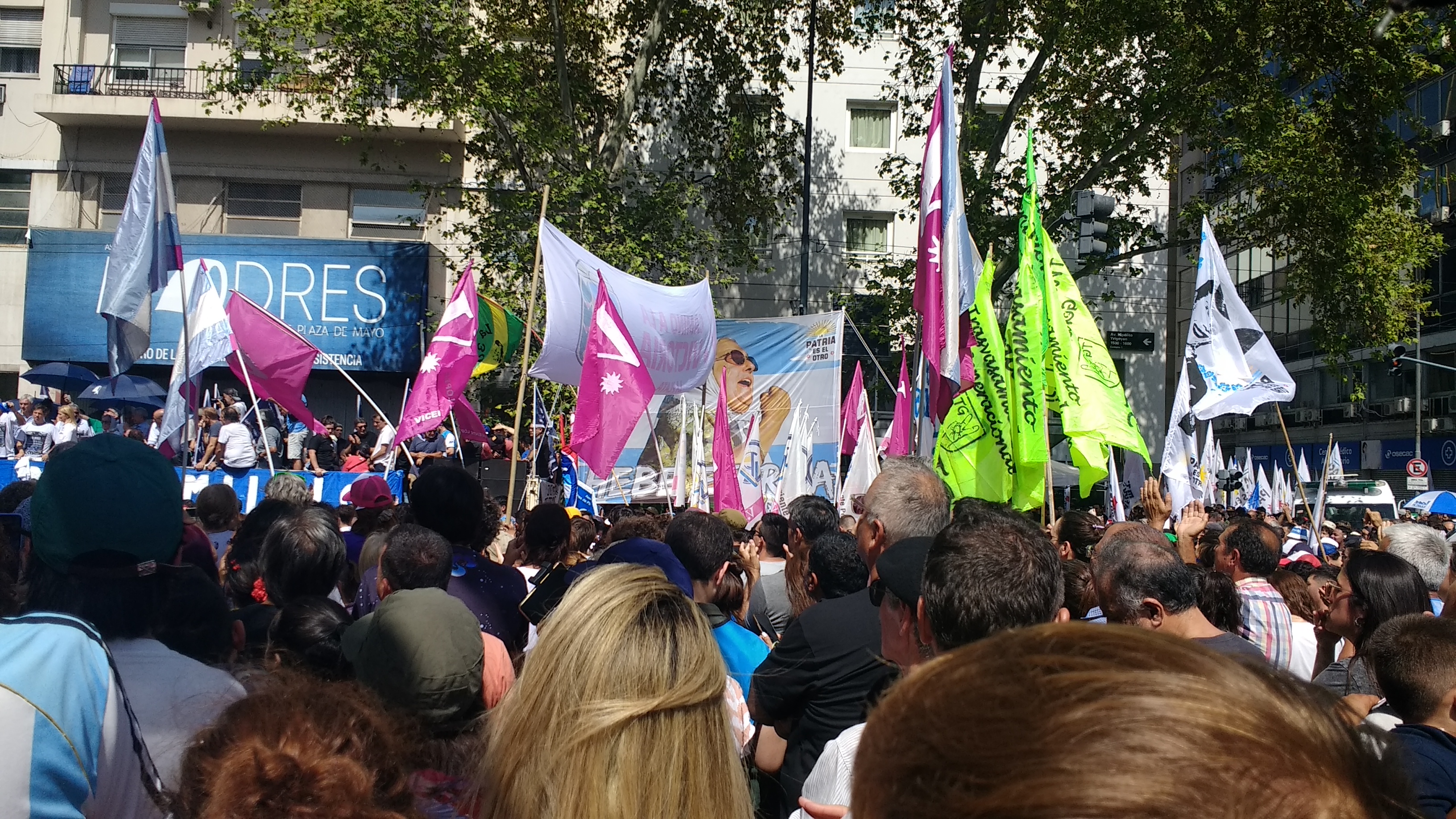Violencia política.
Esta peste se está apropiando de nuestra región cada vez con más fuerza, y en esta oportunidad ya nadie le puede echar la culpa ni a las guerrillas comunistas ni a la corrupción populista: gobiernos de derecha dan lugar a democracias cada vez más débiles, y cada vez más permeables por las organizaciones narco.
En simultaneo, de los pueblos oprimidos brota una reacción tan entendible como desesperada, que es votar a las opciones más agresivas y rupturistas disponibles: como cachetazo y grito de protesta hacia las estructuras de la política históricamente establecida, que no vienen logrando hacer nada al respecto de los problemas populares. Pero para sorpresa de muches, ese rupturiusmo casi inevitablemente se propone por derecha, aún con el vasto registro de instancias fallidas de lo mismo, y con el historial intachable de las derecha ejerciendo poder político en contra de los intereses populares.
Nosotres tenemos algunas cosas para reflexionar al respecto, como siempre mezclando temas de la cultura popular con algunas ideas científicas y nuestras propias teorías agregadas a los análisis. De modo que sin más preámbulos arrancamos con este nuevo trabajo, titulado: “la virtud de los desalmados”.
Introducción
En el año 2019, el canal de youtube “Just Write”, que se dedica mayormente al análisis literario y mediático, publicó un video hablando sobre una ola de videojuegos donde los personajes principales eran padres, y la paternidad era un tema central en esas historias.
A ese fenómeno se lo llamó “the daddening”, y entre otras razones se especulaba que estuviera determinado por la edad de tanto creadores de videojuegos como jugadores. Esa ola arrancó mayormente en la década pasada, cuando mi generación, la primer generación canónicamente “gamer”, ya tenía cumplidos unos 30 años.
Antes de eso, los juegos que escenificaban varones solían mostrar personajes hiperviolentos, hipermasculinizados, e hiperpoderosos, operando como lo que llamaron “power fantasies”, o “fantasía de poder” en español. En líneas generales, la histórica cuestión de “la violencia en los videojuegos” estaba más notoria e iconónicamente en esas power fantasies.
Pero si bien siempre hubo variedad en los videojuegos, en la década pasada aparecieron un montón donde los personajes pasaban a ser mucho más maduros emocionalmente, así como también las historias más complejas y humanas.
Les recomendamos ese video, que de alguna manera es precursor del actual, y de hecho puede ser muy interesante; pueden…
continuar leyendoLa inteligencia artificial lleva meses formando parte de debates sostenidos a nivel mundial en todas las esferas de discusión. Desde titulares en diarios y revistas de todo tipo, hasta opiniones de intelectuales prestigioses e incluso referentes polítiques, por todo el mundo se especula con cuestiones como el reemplazo de seres humanos por inteligencias artificiales en ámbitos laborales, los cambios sociales que se nos avecinan con la explotación de estas tecnologías, o hasta francas ideas apocalípticas. Y en el corazón de este fenómeno está un proyecto que se abrió al público general para su uso, y tuvo muchísima prensa: ChatGPT. Nosotres tenemos algunas cosas para decir al respecto, así que esta vez escribimos directamente una tesis, titulada “de máquinas y revoluciones”.
Disclaimer
Antes de comenzar, corresponde una breve explicación de este video: porque ciertamente es larguísimo para los estándares de consumo actual, y tememos entonces que los momentos menos llevaderos sean pedirle demasiado a cualquier audiencia. Este video pretende dar un panorama de la cuestión Inteligencia Artificial desde diferentes perspectivas, todas mezcladas. La primera de ellas es una perspectiva histórica, y principalmente por eso se hace largo: aquí narramos una historia de la Inteligencia Artificial, seleccionada por nosotres, en sus puntos vinculados a la tecnología, la cultura, las sociedades de cada momento, y el espíritu de época. En segundo lugar, yo que escribí y relato esto soy trabajador de la Informática, y entonces este relato tiene mucho de perspectiva gremial: la Inteligencia Artificial tiene una íntima relación con la Informática, y quienes trabajamos de ello podemos brindar algunos detalles desde la cocina de esas cosas, además de que personalmente me interesa también que por esa vía otres compañeres del gremio tengan contactos con los relatos históricos o historicistas. En tercer lugar, este canal se dedica al contacto entre epistemología, sentimientos, y política, de modo que también el relato concentra buena parte de su cuerpo en tales cuestiones, para nosotres centrales.
Con todo eso, lo que se pretende es un trabajo de divulgación, que al ser heterogéneo en su contenido pueda ofrecerles datos o temas interesantes a diferentes personas. Si une curiosea la historia de la Inteligencia Artificial por internet, frecuentemente se encuentra con planteos por demás técnicos, vinculados a técnicas matemáticas y estadísticas que pueden decirle mucho a la persona informada pero prácticamente nada a todes les…
continuar leyendoVí Argentina, 1985.
La película fue muy recomendada por los y las comunicadores con quienes me informo habitualmente, y está lleno de reseñas mayormente positivas por todos lados. Parece haber un consenso en que la película es mayormente correcta en sus aspectos técnicos, y que está del lado correcto de la historia en sus aspectos ideológicos. Pero con tanta presencia que tuvo, francamente esperaba mucho más de esta película, y de hecho me despierta algunas dudas, cuando no directamente preocupaciones.
En primer lugar, ¿para quién o para qué está pensada esta película? ¿Qué es? ¿Una clase rápida de historia? ¿Una reivindicación de la figura de Strassera y/o del juicio? ¿Un intento por instalar el tema, por difundirlo? ¿Algún acto de humanismo en línea ideológica con la UCR?
Como difusión internacional, me parece que tiene gusto a demasiado poco. ¿Alguien que no sea argentine va a entender las infinitas referencias de la película, los contextos en los que aparecen, los chistes siquiera? Si ese alguien no está empapado de todos los infinitos detalles que se omiten en la historia, o que cuanto mucho aparecen como fugaz referencia, ¿qué le queda de esto? ¿”la historia de un juicio”? Al final de la película, pasadas ya dos horas, aparece una placa que dice “primera vez en la historia universal que un tribunal civil juzga a una dictadura militar”: ¿era tan difícil ponerlo al principio, o en el trailer siquiera?
El trailer es muchísimo mejor que la película. Al menos en lo que respecta al impacto, que es un punto clave a la hora de realizar un trabajo de difusión mediática y cultural. Dice “nadie más se animó desde Núremberg”, poniendo el eje del conflicto en el lugar correcto; pero francamente “el juicio más importante de la historia argentina” no veo que le importe mucho a nadie fuera de Argentina: al menos, no imagino a mis compatriotas argentines intrigades por “el juicio más importante de la historia de Haití”, ni el de Laos, ni el de Pakistán o Islandia, y entonces proyecto que en el resto del mundo la gente se comportará más o menos parecido con respecto al de Argentina. De modo que, salvo por el hecho de que es una película de género con todas sus reglas cumplidas al pié de la letra (fácil entonces de adecuarse a ella como espectador),…
continuar leyendo Ayer Jueves primero de Septiembre de 2022, mi país Argentina vivió un evento bisagra en su historia reciente: el magnicidio fallido contra Cristina Kirchner.
Muchas cosas se pueden decir sobre el evento, muchos debates se abren, y las consecuencias concretas apenas podemos ir imaginándolas día a día; diría, más bien viviéndolas. Sin embargo, me interesa dejar anotado un fenómeno profundamente preocupante. He visto compañeres, militantes de izquierda, con años de trabajo y de estudios universitarios, con interés en la política y en la historia, explicar al fallido magnicidio como el accionar de “un loquito suelto”: a veces por “ser objetives”, otras veces con afán de “considerar todas las alternativas, para poder caracterizar correctamente”, a veces por “no ser paranóiques”, y algunas otras razones seguramente han de poder articularse para ir hacia esa línea de pensamiento. En esa aventura, me han llegado a decir cosas como “la historia que tiene este país y esta region no tiene mucho que ver con este chabon, ni lo que hizo”, refiriéndose lógicamente al agresor.
O bien incluso esto otro: “que haya una construcción más o menos novedosa, más o menos específica, más o menos identificable, pero sistemática, de una forma del odio, no quita que además haya un loquito suelto”.
Al caso de todo esto, pretendo ser absolutamente categórico: hablar de “loquito suelto” en el contexto que estamos viviendo, es absoluta, indiscutible, y escandalosamente, negacionista. Las complejidades involucradas no cambian nada en ese hecho, y no hay un ápice de espacio para ningún relativismo al respecto. Así que en esta entrada voy a dejar anotado algunos detalles, de manera completamente desordenada, acerca de por qué eso es así.
Primero y principal, mi respuesta a aquellas insinuaciones de “racionalidad” y “categorización correcta”: no se trata de “un loco”, sino de “un loco empoderado“. Y ese empoderamiento tiene autores intelectuales. Si vamos a jugar al negacionismo sobre cosas como la estigmatización, criminalización, y deshumanización, 24/7 desde hace años, primeramente desde medios de comunicación y luego desde espacios formalmente institucionales como los poderes legislativos y judicial, especialmente con la historia que tiene este pais y esta región, entonces por favor cerremos todo porque “política” pasa a ser una cosa que solamente existe en libros de ficción francamente bastante aburridos. Y me refiero a cosas como las que se pueden apreciar en las siguientes imágenes:

Oración para cuando les fanátiques de la razón se pongan denses.
Dondequiera que miremos y sean cuales fueren los ejemplos que consideremos, vemos que los principios del racionalismo crítico (tomar en serio las falsaciones; aumentar el contenido; evitar las hipótesis ad hoc; ‘ser honestos’, cualquiera que sea el significado de esta expresión, etc.) y, a fortiori, los principios del empirismo lógico (ser rigurosos, basar las teorías sobre mediciones; evitar las ideas vagas e inestables, etc.), ofrecen una explicación inadecuada del desarrollo pasado de la ciencia y tienden a obstaculizar la ciencia en el futuro. Ofrecen una explicación inadecuada de la ciencia porque la ciencia es mucho más ‘cenagosa’ e ‘irracional’ que su imagen metodológica. Y tienden a obstaculizarla porque el intento de hacer más ‘racional’ y más rigurosa la ciencia desemboca, como hemos visto, en su destrucción.
En consecuencia, la diferencia entre ciencia y metodología, que constituye un hecho histórico obvio, indica una debilidad de esta última y tal vez también de las ‘leyes de la razón’. Pues, lo que parece ser ‘ciénaga’, ‘caos’ y ‘oportunismo’ al compararse con tales leyes, tiene una función muy importante en el desarrollo de las teorías que hoy consideramos como partes esenciales de nuestro conocimiento de la naturaleza. Semejantes ‘desviaciones’ y ‘errores’ son prerrequisitos del progreso. Permiten al conocimiento sobrevivir en este complejo y difícil mundo que habitamos, y permiten que nosotros continuemos siendo agentes libres y felices. Sin ‘caos’, no hay conocimiento. Sin un olvido frecuente de la razón, no hay progreso. Las ideas que hoy día constituyen la base misma de la ciencia existen sólo porque hubo cosas tales como el prejuicio, el engaño y la pasión; porque estas cosas se opusieron a la razón; y porque se les permitió seguir su camino. Hemos de concluir, pues, que incluso en ciencia la razón no puede ser, y no debería permitirse que fuera, comprehensiva y que debe ser marginada, o eliminada, con frecuencia en favor de otras instancias. No existe una sola regla que continúe siendo válida en todas las circunstancias y no existe una sola instancia a la que se pueda apelar siempre.Ahora bien, debemos recordar que esta conclusión ha sido referida partiendo de la condición de que la ciencia, tal y como la conocemos hoy día, permanezca incambiada y de que se permita a los procedimientos que ella emplea determinar su desarrollo futuro. Dada la ciencia, la razón no puede ser universal…
continuar leyendo
Este es el texto del video publicado hoy en filosofeels. El texto fue redactado entre el 20 y el 30 del pasado Marzo. Algunas líneas fueron cambiadas a la hora de realizar la grabación, pero fueron cambios mínimos.
Attack on Titan está llegando a su fín, y todo indica que no va a pasar nada bueno en ese final. De hecho, todo indica que va a tener el peor de los finales: genocidio a escala planetaria. Ya veremos eventualmente qué termina sucediendo. Pero de una manera u otra, lo que tenemos hasta acá nos permite pensar algunas cosas que no quisiéramos dejar de anotar, porque nuestro mundo real parece estar necesitando cada día con más urgencia algunas reflexiones. Pero esta vuelta mejor prepárense algunos pochoclos o búsquense algo para acompañar el mate, porque en nuestro afán de no separar algunas cosas relacionadas, el video terminó siendo excepcionalmente largo. Así que sin más preámbulos, arranquemos con este ensayo: Attack on Titan, cuando pase el temblor. Que, por supuesto, está lleno de spoilers.
Parte 1: Memoria
La serie ya se viene estirando por varios años, los giros argumentales son densos, la última temporada se está haciendo más larga de lo prometido, y con todo eso corresponde tal vez un breve resumen para refrescar y dar un poco de contexto.
Esta historia, recordemos, arranca con una escena monstruosa: un titán devorando a la madre del jóven Eren Yaeger mientras él observaba todo. Y no sólo a su madre, sino que los titanes ese día destruyeron su ciudad, y mataron a miles. Pero después resultó que sus propios compatriotas y colegas lo consideraron un monstruo cuando se reveló que él podía convertirse en titán, independientemente de sus acciones; y él pudo eventualmente contemplar sus propios actos monstruosos al recordar que devoró a su padre, aún en una situación más bien inconsciente; además de contemplar los actos monstruosos de su padre, por supuesto. Como si todo eso fuera poco, la razón por la que ese pueblo está aislado del resto del mundo, es porque el resto del mundo los considera monstruos, al punto tal que a les eldianes fuera de la isla no tienen derechos plenos de ciudadanía y hasta directamente les toca vivir en campos de concentración.
Entonces, básicamente, después de años de experiencias y revelaciones una más mortificante que la otra, el…
continuar leyendo¡Un nuevo artículo en Nuclear!.
Se titula De Adam Smith a Facebook, y continúa los puntos que habían sido introducidos en el anterior: La insoportable levedad del bit.
En esta oportunidad retomamos desde la pregunta “por qué la izquierda no parece abrazar a la tecnología, que parece ser cosa siempre de derechas”, y para eso vamos a un poco de historia de ambas: de la tecnología (con foco en la informática), de la izquierda, y de nuestra derecha contemporánea.
https://nuclear.com.ar/2021/11/01/de-adam-smith-a-facebook/.
continuar leyendoUna reflexión cortita, como nota rápida para no dejarla pasar. Mi sesgo anti-economicista es explícito: tengo una postura muy fuerte contraria a las explicaciones de la sociedad desde la economía. Las economicistas me parecen posturas agotadas, y a esta altura francamente dañinas. De modo que no hay sorpresas en este texto por ese lado. Pero eso no quita que el debate en términos económicos no tenga lugar legítimo en la sociedad, y cabe también la pregunta por cuál es ese lugar.
El ecosistema ideológico economicista contemporáneo se divide, a gran escala, básicamente en tres partes: corrientes marxistas, neoliberalismo, y keynesianismo. Sin dudas hay matices, pero tampoco creo que nadie vaya a negar esas tres corrientes de pensamiento como herramientas principales de reflexión acerca de la realidad económico-social. Y apenas me gustaría anotar tres problemas diferentes que tiene cada corriente, en especial a la hora de la integración: sea con otras corrientes económicas, sea con otras filosofías enteras.
Problemas, a vuelo de pájaro
El mayor problema del marxismo es su enorme profundidad y cuota de verdad. En castellano: “el problema del marxismo es que tiene razón”. Y eso es un problema porque “tiene razón” sólo hasta cierto punto, más allá de lo cuál comienza a tener problemas muy serios.
Es un problema análogo al de la física, cuando aparecieron relatividad y/o cuántica: la mecánica clásica “tiene razón”, excepto cuando ya no la tiene, y es tan profundo lo que eso dice sobre nuestra realidad que sencillamente cuesta entender de qué estamos hablando cuando expresamos nuestros teoremas clásicos. Son casos particulares de cosas mucho, mucho más complicadas (o simplemente diferentes) que aquello interpretado entre los siglos XVII a XIX; y no por eso dejan de ser casos suficientemente generales para explicar sistemas gigantezcos, y de hecho aquellos en particular con los que tenemos contacto en nuestra interacción cotidiana.
Eso es el marxismo para buena parte de las explicaciones sociales contemporáneas: pero sin cuántica ni relatividad que le cuestione nada sobre la sociedad ni la humanidad. Cuando las cosas se le empiezan a escapar de las manos al marxismo en el debate por la comprensión de fenómenos sociales, los problemas se vuelven insoportablemente dificiles de discutir por la compleja carga teórica que el marxismo exige, dejando esas discusiones a círculos inaceptablemente pequeños de personas, y a esos círculos más bien aislados entre sí. Todo esto no es ninguna revelación: cualquiera que se fija puede…
continuar leyendo

